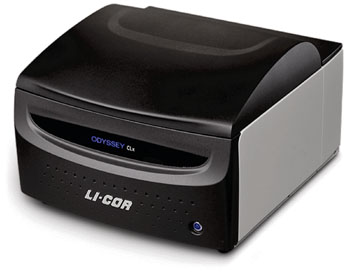Parkinson's Disease Biomarker Found in Urinary Samples
By LabMedica International staff writers
Posted on 20 Jul 2016
A biomarker helps physicians predict, diagnose or monitor disease, because the biomarker corresponds to the presence or risk of disease, and its levels may change as the disease progresses.Posted on 20 Jul 2016
The biomarker gene, leucine-rich repeat kinase 2 (LRRK2), has been shown to play a role in hereditary Parkinson's, and the most common of these mutations, called G2019S causes the LRRK2 kinase to add too many phosphates to itself and other proteins, but why this leads to Parkinson's disease is not yet clear.

Image: The Odyssey CLx scanner for Western Blot analysis (Photo courtesy of LiCor).
Scientists at the University of Alabama at Birmingham (AL, USA) found that elevated phosphorylated LRRK2 predicted the risk for onset of Parkinson's disease for people carrying a mutation in LRRK2, which is about 2% to 3% of all Parkinson's disease patients. They tested these findings with a preliminary, 14-person cohort of urine samples from the Columbia University Movement Disorders Center. That was followed by a larger replication study of 72 biobanked urine samples from the Michael J. Fox Foundation LRRK2 Cohort Consortium. The participants included 18 mutation carriers with Parkinson’s disease (PD), 18 mutation carriers without PD, 18 non-carriers with PD, and 18 non-carriers without PD.
Exosomes were isolated from coded frozen urine by rapid thawing in a shaking heated water bath followed by differential ultracentrifugation. Exosome proteins TSG101, total LRRK2, and Ser(P)-1292 LRRK2 were measured by Western blot and LiCor Odyssey scanner analysis (Lincoln, NE,USA). An exosomal pellet and a corresponding exosome protein marker (TSG101) were detected by Western blot in all lysates from all participants in the study, and LRRK2 was measurable in all preparations.
The scientists found that approximately 20% of people without LRRK2 mutations but with Parkinson's disease also showed highly elevated phosphorylated LRRK2 similar to people with LRRK2 mutations, and this was not present in healthy controls. The study speculates that people with elevated phosphorylated LRRK2 may be particularly good candidates for future drugs that reduce phosphorylated LRRK2. The urine exosome Ser(P)-1292 LRRK2 to total LRRK2 ratio showed a risk prediction statistic of 0.844 for clinical manifestation of PD.
The authors concluded that an elevated ratio of phosphorylated Ser-1292 LRRK2 to total LRRK2 in urine exosomes predicted LRRK2 mutation status and PD risk among LRRK2 mutation carriers. Future studies may explore whether interventions that reduce this ratio may also reduce PD risk. The study was published originally in March 2016 in the journal Neurology and has since been expanded on June 14, 2016, in the journal Movement Disorders.
Related Links:
University of Alabama at Birmingham
LiCor














